How to Fix AirPlay No Sound Issues
Experiencing sound problems with AirPlay? This article explores the causes of no sound on AirPlay and provides easy solutions to fix the no-sound issue.
Screen Mirroring & AirPlay Tips
iPhone/Android Mirroring
How to Fix AirPlay No Sound Issues
Screen mirroring your iPhone and Android to the computer with ease.
- Fast response time within 10 ms and 60fps frame rate.
- A stunning visual experience with no color difference.
- Lag-free screen mirroring and 4k resolution.
- Works well on both Windows and macOS.
Available for both Win & Mac
Experiencing sound problems when using AirPlay can be quite frustrating as it hinders your ability to hear any music or audio on your TV while screen mirroring. The absence of sound on AirPlay can happen for different reasons, including improper HDMI cable connection, network connection issues, problems with the hardware, etc.
Luckily, there are many easy solutions available to quickly fix the AirPlay no-sound problem.
In this article, we will explore the most efficient workarounds to help you overcome sound not working on AirPlay issues.
Table of ContentsHide
Causes of AirPlay No Sound Issue
1. Silent mode or muted settings on your Apple devices
One common reason for experiencing no sound on AirPlay is accidentally having your Apple device in silent mode or having the volume muted. It’s important to check the silent mode switch or the volume settings and ensure that the volume is not turned all the way down.
2. Improper HDMI cable connection on the TV
If you are using an HDMI cable to connect your Apple device to the TV, an improper connection or a faulty cable can result in no sound. Make sure the HDMI cable is securely connected to both the Apple device and the TV, and try using a different cable if necessary.
3. Software glitches or temporary bugs
Temporary software glitches or bugs can sometimes occur and cause issues with sound not working on AirPlay. Restarting the Apple device and the receiving device can help refresh the system and resolve temporary software issues.
4. Insufficient internet speed
AirPlay relies on a stable internet connection to stream content. If your internet speed is too slow or inconsistent, it can lead to sound interruptions or no sound at all.
5. Damage to the external or inbuilt TV speakers
Physical damage to the external or inbuilt speakers of your TV can also result in AirPlay no-sound issues. Check the speakers and try connecting external speakers or headphones to your TV to see if the sound works through them.
6. Modifications in audio output settings
Sometimes, changes or modifications made to the audio output settings on your Apple device or the receiving device can affect AirPlay sound. Make sure the audio output settings are properly configured and set to the desired output source.
How to Fix AirPlay No Sound Issues?
1. Disable Silent Mode
To enable sound during AirPlay, you can adjust the Silent Mode switch on your device. Depending on your device model, the Silent Mode switch is typically located on the side of your device. You can also adjust the sound volume in Settings.

Disable Silent Mode
- For iPhone 7 and later users, go to Settings > Sound & Haptics.
- For earlier users, go to Settings > Sounds.
2. Check the HDMI Connection
To ensure a correct HDMI connection, start by unplugging the HDMI cable from both your Apple device and the TV. Then, reinsert the cable firmly into the HDMI ports on both devices, making sure it is tightly connected. Sometimes, a loose connection can result in an AirPlay no-sound problem.
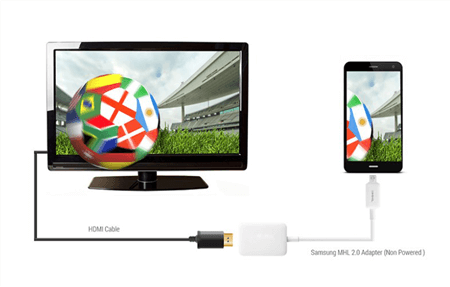
Mirror via HDMI Cable
If the issue persists, try reversing the ends of the HDMI cable. In some cases, one end of the cable may be faulty or incorrectly inserted.
If none of the above steps resolve the issue, it’s possible that the HDMI cable itself may be damaged or incompatible. Consider replacing the HDMI cable with a new one, ensuring that it is compatible with both your Apple device and the TV. A high-quality HDMI cable can make a significant difference in the quality of your AirPlay streaming and help ensure sound is transmitted properly.
3. Adding Core Audio to Firewall Exceptions
To add Core Audio to Firewall exceptions on your Mac, follow these steps:
Step 1. Click on the Apple menu and select “System Preferences”.
Step 2. In the System Preferences window, locate and click on the “Security & Privacy” icon.
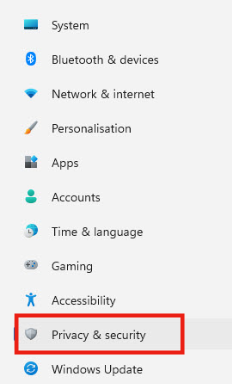
Open System Preferences
Step 3. Select the Firewall tab.
Step 4. Click the “Firewall Options” button.
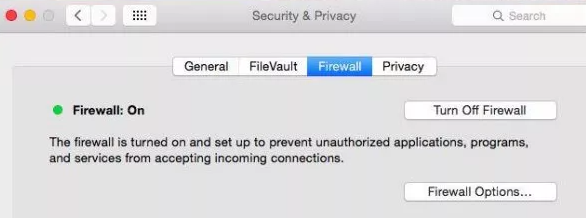
The Firewall Option
Step 5. Click on Add Application (+) and choose Core Audio
4. Connect AirPlay Devices to a 2.4 GHz Network:
If you have a 5GHz router and you’re experiencing issues with AirPlay stability, it’s recommended to connect both your AirPlay sender (e.g., iPhone, iPad) and the receiving device (e.g., Apple TV, speakers) to a 2.4 GHz network. While the 5GHz network offers faster speeds, the 2.4 GHz network generally provides better range and stability, especially over longer distances or through walls.
This means keeping them within a reasonable distance from the WiFi router to minimize the risk of signal interference or loss. By connecting your AirPlay devices to a 2.4 GHz network and ensuring they are within range, you can optimize the stability of your AirPlay streaming experience.
5. Update the App
Update the incompatible app on your iPhone, iPad, or Mac to ensure compatibility with AirPlay. Developers often release updates that include AirPlay support or bug fixes, which can resolve any compatibility issues with AirPlay.
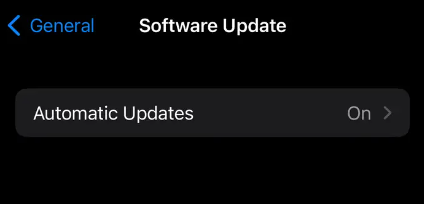
The Setting of Updates
6. Power Cycle Your Apple TV
If you’re experiencing interruptions in the audio system or encountering software glitches and bugs on your Apple TV, one effective troubleshooting step you can take is to power cycle your device. It helps clear temporary AirPlay sound issues that may be affecting the audio system.
To power cycle your Apple TV, follow these steps:
Step 1. Turn off your Apple TV and unplug the power cord.
Step 2. Wait for a few minutes, unplugged.
Step 3. Now plug it back into the power.
AnyMiro: Best Alternative to AirPlay
AnyMiro is a versatile and powerful multimedia streaming app that empowers users to stream reliable and high-quality media across various platforms and devices. This innovative app allows users to effortlessly mirror content from their mobile devices or computers onto larger screens, enabling a seamless and immersive viewing experience and avoiding AirPlay no-sound issues.
With AnyMiro, you can easily share your photos, videos, presentations, and even gameplay with others in real-time. Gone are the days of worrying about issues that may arise with AirPlay, such as sound not working. AnyMiro eliminates these complications by providing a stable and smooth streaming experience, ensuring that your content is shared flawlessly and without interruption.
Key features:
Easy to Use: AnyMiro makes it incredibly straightforward to mirror your phone screen to a PC. With its user-friendly interface and intuitive design, you will find it super easy to set up and use the app for screen mirroring purposes.
Ensures a stable mirroring connection: AnyMiro allows uninterrupted screen mirroring for extended periods, up to 10 hours, during activities like mobile gaming or drawing streams.
4K Resolution with Color Accuracy: It supports up to 4K resolution, as vibrant as your original screen, which delivers the best color accuracy for an immersive visual experience.
Let’s go through the steps on how to use AnyMiro to address the issue of sound not working. Here take the iPhone as an example.
Mirror iPhone to PC via USB
Step 1. Download and run AnyMiro on your computer.
Free Download for all windows & 100% safe Free Download for all mac & 100% safe
Free Download100% Clean & Safe
Step 2. Select mirror iPhone/iPad to enter iPhone mirroring.

Mirror iPhone to Computer
Step 3. Connect your iPhone to a PC with a lightning cable.
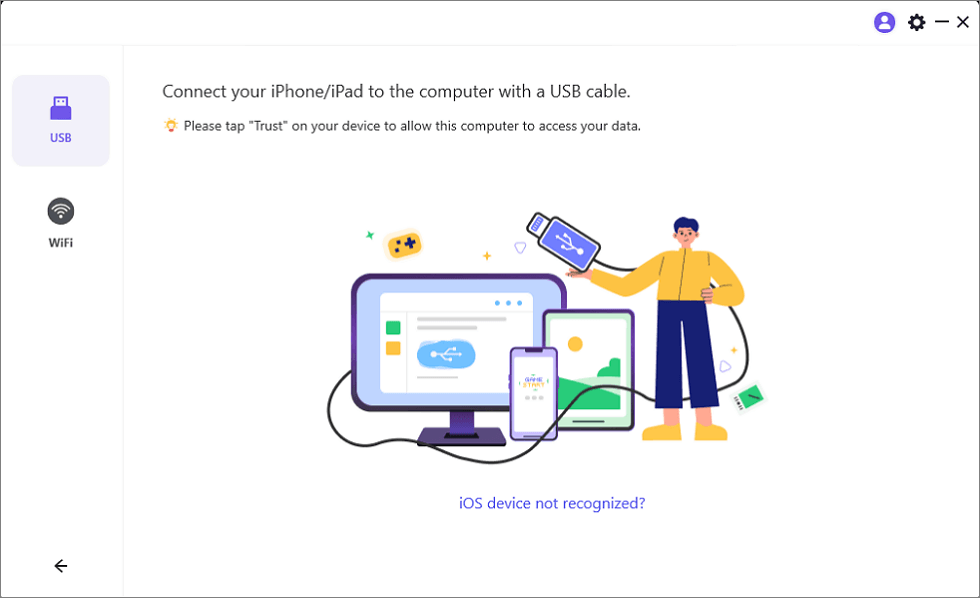
Mirror iOS Device to Computer via USB
Step 4. Tap “Trust” on your iPhone, and wait a few seconds, you can see the iPhone screen on the computer.
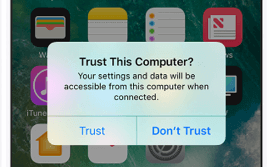
Trust Your Computer on iPhone
Mirror iPhone to PC -Wirelessly
Step 1. Download and run AnyMiro on your computer.
Step 2. Go to the iPhone/iPad mirror section.

Mirror iPhone to Computer
Step 3. Switch to the WiFi connection part. Connect your iPhone and PC to the same WiFi.
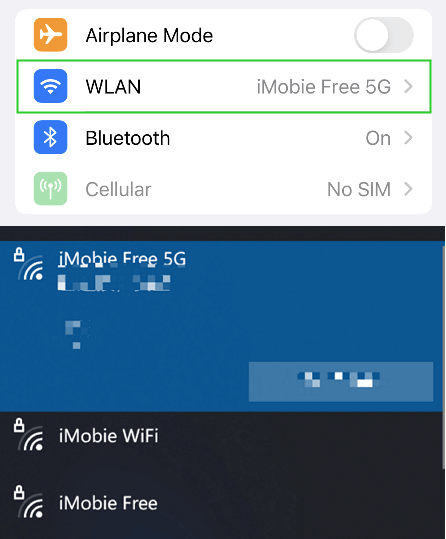
Connect to the Same WiFi
Step 4. Follow the on-screen steps, select your PC from the list, and start mirroring iPhone.

Mobile Screen Mirrored on the Computer with AnyMiro
FAQs
1. How do you reset AirPlay on your iPhone?
Here’s how: Open the Settings app on your iOS device. Tap General and then tap Reset.
2. Does Netflix block AirPlay?
Yes. According to a support page on Netflix’s official website, Airplay is no longer supported for use with Netflix due to technical limitations. Netflix has explained that it has removed the AirPlay feature to ensure the technical limitations.
3. Can I mirror an iPhone without AirPlay?
Yes, you can mirror an iPhone to another device by using a third-party app such as AnyMiro.
Conclusion
Experiencing the “sound not working on Airplay” issue can be frustrating, but there are many easy solutions available to quickly fix the no-sound issue.
This article explored the causes of no sound on AirPlay. Step-by-step instructions were provided to resolve the no-sound problem, such as disabling silent mode, checking HDMI connections, adding Core Audio to firewall exceptions, connecting devices to a 2.4 GHz network, updating incompatible apps, and power cycling your Apple TV.
AnyMiro was introduced as a reliable alternative to AirPlay, offering easy-to-use screen mirroring, stable connections, and high-quality streaming without worrying about sound not working on Airplay. So if you face AirPlay not working issue and want to screen mirror your phone to another device, give AnyMiro a try.
AnyMiro – Real-Time Screen Mirroring Tool
Free download AnyMiro to enjoy a fast, stable, and smooth screen mirroring experience. You can mirror for better game playing, video watching, or live streaming mobile phone content.
More Related Articles
Product-related questions? Contact Our Support Team to Get Quick Solution >

